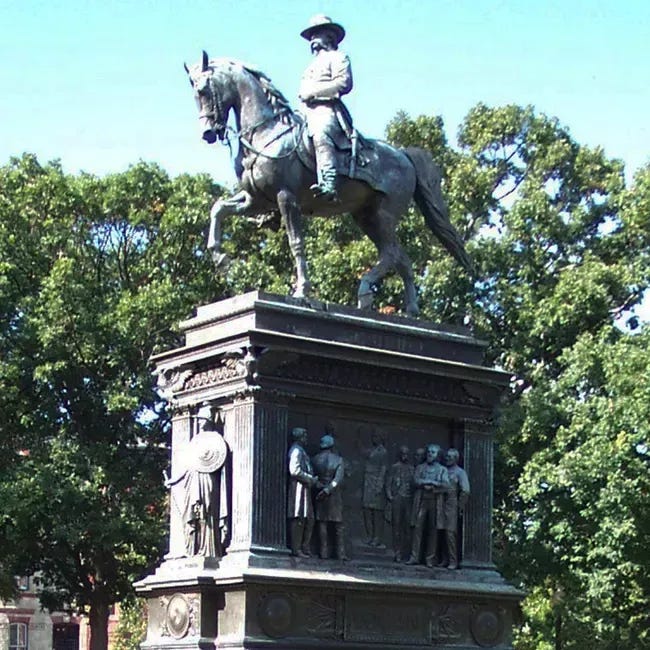For many years I worked at an office a few blocks from Logan Circle in DC. Our capital is filled with circles featuring a little remembered general on horseback. Being close by, I’d wander around and explore. General John A. Logan was a civil war hero, a military amateur who excelled on the battlefield (unlike most of politicians who were gifted a command.) He was the second commander of the Grand Army of the Republic, a Civil War veterans association that became an interest group of unprecedented power in the decades after that war.
A politician, Logan was a house manager in the impeachment of Andrew Johnson. He later became a Senator and, on the strength of his support among Civil War veterans, was named Republican candidate for vice president in 1884. He was the running mate of James G. Blaine (“the Continental Liar from the state of Maine”), who was widely seen as corrupt. By 1884 the Republicans had one six straight victories in presidential elections. Blaine and Logan lost, narrowly, to Grover Cleveland and Thomas Hendricks (the second of sixth vice presidents from Indiana.)
In his early political career, Logan had been a follower of Stephen Douglas, a Democrat who sought to keep the Union together and elide the slavery issue. As a Douglas Democrat, Logan supported racist legislation that restricted the rights of free African-Americans in Illinois. During the war, Logan fully converted to the abolitionist cause. Frederick Douglass was a friend who readily praised him. In a eulogy at the death of Republic Senator Roscoe Conkling in 1888, Douglass spoke with great sadness about the passing of the giants who had made abolition possible:
Of John A. Logan it is only needed to say that he was the dread of traitors, the defender of loyal soldiers, and the true friend of the newly-made citizens of the Republic. Much was predicated for our cause on this man’s future. But he, too, in the order of Providence, has laid off his armor. For one, I thought it had been he, through whom we might regain the ground lost during the last dozen years.
Making Memorial Day
A great man, perhaps his longest lasting contribution was the establishment of Memorial Day. As the commander of the Grand Army of the Republic, he wielded his vast influence to drive this initiative. The scale of the Civil War is difficult to comprehend. At least one in fifty Americans was killed (imagine seven million Americans lost today), and many more left with lasting physical and psychological scars. No one was untouched. It was originally “Decoration Day” when loved ones visited cemeteries and decorated the graves of those they lost. Americans needed this commemoration of those they lost.
We still do.
Time has misted the original purpose of Memorial Day. It was a solemn remembrance of those who laid down their lives in the just cause of ending slavery. Memorial Day belongs to all of us, and should commemorate all Americans who laid down their lives in national service—whatever the justice of the cause. But we should also remember its origins.
The First Memorial Day
As it happens, I am writing this in Charleston, South Carolina, which may have been home to the first Memorial Day celebration.
A lovely city of beautiful historic buildings, upscale restaurants, and roving bachelorette parties. Charleston was, from the Colonial era through the antebellum era, the great city of the south. This wealth was built on slavery. As the leading southern colonial and east coast port, Charleston was central to the trans-Atlantic slave trade. When that was ended, Charleston remained central to the domestic slave trade. The old slave market is now a museum which discusses in detail the organization, economics, and human cost of this abomination. The city is struggling to acknowledge its past, but at least it is trying.
Vice President John C. Calhoun of South Carolina was one of the leading architects of the ideology that underpinned the slavocracy. More on him another time. It was also Charleston where the Civil War started with the attack on Fort Sumter.
It is fitting (if true) that the first Memorial Day was also in this city. During the war, a posh club and racetrack were converted into a prison camp for captured Union soldiers, hundreds of whom died from disease and exposure. They were buried in a mass grave. When the city was liberated, the freed slaves gave them a proper burial. Then a few months later, the city’s now free African-American citizens held a parade and a solemn ceremony to commemorate those who died to liberate them.
Wars never really end, not for societies nor for individuals. Their effects continue to ripple through history, even when names and stories are long forgotten. We need Memorial Day, as a nation and as individuals, to remember and to honor.





